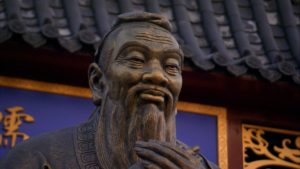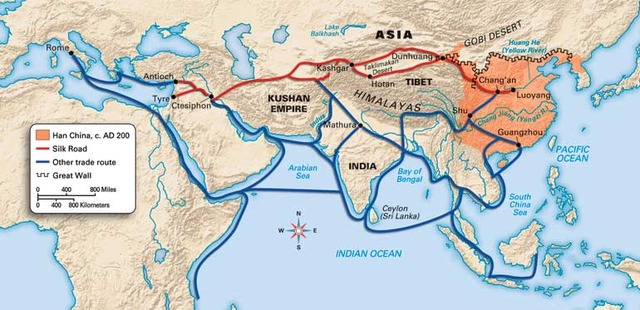Confucianism

Another religion that arose in conjunction with the great East-West trade was Confucianism. It became the official belief system of China during the powerful and influential Han dynasty. This dynasty encompassed the entire eastern half of present day China and emerged in 206 BC or about 25 years after the era of Ashoka and his violent reign through India. Confucius lived from 551 to 479 BC. His teachings promoted humaneness, kindness, and decency towards others. Confucius taught that all human beings are fundamentally good by nature. He had no tolerance for hate. Confucius believed in a strong central government.
Confucianism helped to consolidate the many Chinese factions, who were often at war with one another, into a unified body. According to John Houkas, the first head of the Purdue University Libraries’ Special Collection of Literature in Business and Economic History, Confucius didn’t see usury as a problem.
Meron Medzini in Confucianism and the Jewish Way of Life,
(Confucius) did not offer material gains and benefits to those who followed his teachings, he focused his attention not on the masses but rather on a small elite who were called gentlemen, who would concentrate upon the attainment and maintenance of higher goals.
…
(When) it came to the common people, he taught that they had to be led, cared for, and taught by the ruling classes. There would be no change in their status, lest it would lead to the collapse of the social order.
…
On the contrary, one way of ruling over China by non-Chinese dynasties, such as the Ching dynasty, was to adopt Confucianism as the way of life, adopt the educational system and content, promote people because of their learning and impose the examination system on their civil servants.
International trade proliferated during the Han dynasty. The dynasty lasted until 220 CE or just over 400 years. The Han dynasty generated a lot of wealth through international trade and banking. During the Han dynasty numerous trade routes connected China to the Levant, including the notable Silk Road.

In a lot of ways the Han dynasty resembled the United States, both of which were mighty nation-states.
Both Han China and the United States:
- were large in terms of geographic size and had lots of natural resources
- saw tremendous growth of cities
- allowed capitalists a large degree of freedom
- allowed foreigners to do business in their country
- saw large public works projects financed by private entities and individuals
- had a standardized national currency
- had power and wealth concentrated in a few hands
- had a sophisticated banking and monetary system
- practiced international trade and globalism
- had a religion and a society that promoted pacifism and acceptance of strangers
From the Wikipedia entry, Economy of the Han Dynasty (2/1/22):
In the early Han period, rural peasant farmers were largely self-sufficient, but they began to rely heavily upon commercial exchanges with the wealthy landowners of large agricultural estates. Many peasants subsequently fell into debt and were forced to become either hired laborers or rent-paying tenants of the land-owning classes. The Han government continually strove to provide economic aid to poor farmers, who had to compete with powerful and influential nobles, landowners, and merchants. The government tried to limit the power of these wealthy groups through heavy taxation and bureaucratic regulation. Emperor Wu’s (r. 141–87 BC) government even nationalized the iron and salt industries; however, these government monopolies were abolished during Eastern Han. Increasing government intervention in the private economy during the late 2nd century BC severely weakened the commercial merchant class. This allowed wealthy landowners to increase their power and to ensure the continuation of an agrarian-dominated economy. The wealthy landlords eventually dominated commercial activities as well, maintaining control over the rural peasants—upon whom the government relied for tax revenues, military manpower, and public works labor. By the 180s AD, economic and political crises had caused the Han government to become heavily decentralized, while the great landowners became increasingly independent and powerful in their communities.
Who were those wealthy landowners and merchants? Who has traditionally been the traders, bankers, capitalists, and large generators of wealth?
Usury in Ancient China
There is evidence that debilitating levels of usury had been practiced in China even before the Han dynasty came into power.
During the Spring and Autumn Period (722-481 BC) and the Warring States Period (403-221 BC), with the emergence of the metal currency-gold, the claws of ancient Chinese usury extended to the people. The turmoil brought about by the war, famines, and excessive expropriation by the rulers of various countries have brought down the unresistible civilians, and the demand for borrowing is soaring. At the same time, wealthy businessmen and bureaucrats with large amounts of wealth have become the main ones. Lenders. There are two main forms of lending: currency and grain. Taking Qi as an example, “Guanzi·Lightweight” records that the grain lending interest rate in the southern part of Qi is “a few hundred and five out of ten”, that is, the annual rate is 50%. The interest rate is as high as 100%.
Jews of Ancient China
Early evidence shows that Kaifeng Jews have lived in China at least since the Tang dynasty (618-907 CE). According to ibn Khordadbeh, another group of Jews, the Radhanites, entered China during the 9th century. Many of those Jews traded European male and female slaves to the Chinese.
Kaifeng Jews

There are others that have speculated that the Jews arrived in China well before the 7th or 8th century. I happen to be in that camp. I base that on the similarities of the “Chinese” business practices in ancient times compared to that of the modern nation states in today’s times. I believe that the Jews came into China before the Han dynasty and probably sometimes during the Zhou dynasty. It was during the Zhou era that Jews set things up so that when the Hans came into power everything for the Jews was already in place. The Zhou era eventually paved the way for the Han.
Jews in China during the Zhou dynasty
Evidence for Jewish presence in China that predates the Tang dynasty is scarce but there may be a few clues. The Zhou Dynasty reigned from 1050 to 771 BC in western China (known as Western Zhou) and from 770 to 256 BC in eastern China, known as the Eastern Zhou. The Han dynasty succeeded the Zhou dynasty. Abbe Sionnet published a book in 1837 titled Essai sur les Juifs de la Chine (Essay on the Jews of China). Sionnet noted Jewish influences in Chinese society by looking at Chinese folk tales that dated back to the Zhou Dynasty. For instance, allusions were made to the Paradise, the Tree of Knowledge of Good and Evil, the Great Flood, the Rainbow after the Deluge, the woman changed to a statue and the rock which gave out water when struck by a rod. The coincidences between the Judaic scriptures and the folk tales of the Zhou Dynasty cannot be dismissed.
Also in the Bible, Isaiah 49:12 (NKJV)
Surely these shall come from afar;
Look! Those from the north and the west,
And these from the land of Sinim.”
Menasseh ben Israel, the chief rabbi of Amsterdam, in 1650 stated that Sinim referred to China. Sinim is similar to Sina or China. Ben Israel believed the Jews entered China between the period of Isaiah (525-500 BC) and the dispersion of Israel (733-32 BC).
Conclusion
Confucianism shares many similarities to Buddhism and other mass religions. It is a religion that has helped to facilitate the Jew World Order. Like Buddhism and Hinduism, Confucianism supported global trade and concentrated power in the hands of a few. Were Jews behind Confucianism? I’ll let you be the judge.
Next Chapter – Societies Before Organized Religion (due 2/22/22)

